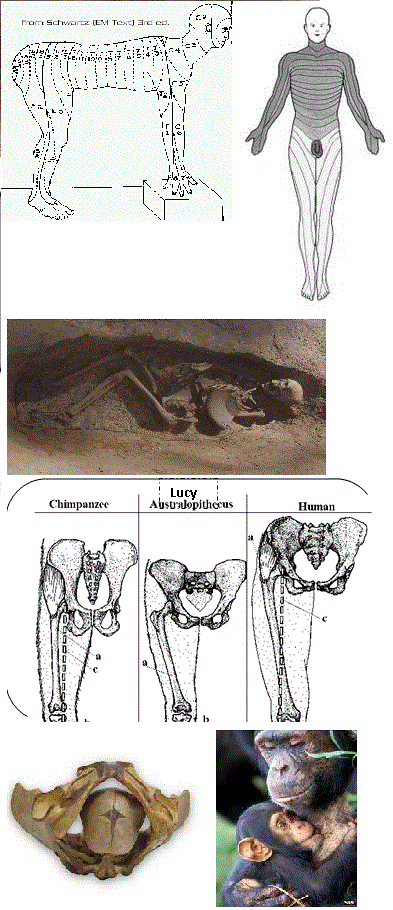Was bipedalism worth it?
Reference:1.Ackerman, J. The National Geographic Magazine,2006 NGM.com
2. Jurmain R Degenerative joint disease in African great apes: an evolutionary perspective. Journal of Human Evolution 09/2000; 39(2):185-203.
Stand up and extend your lumbar spine – did you know that we are the only mammals with the ability to do that? Notice how the dermatome map makes more sense when the human model is positioned on all fours. Since we became bipedal (approx. 7 million yrs ago), the nerves CURVE around our legs instead of going directly down in a straight line as they do in all other mammals.
I am certain that being bipedal had advantages such as being able to carry food, tools etc. while walking. The lordosis and the greater extension in our spines has perhaps made us better bipedal runners but bipedalism has come with a host of uniquely common human maladies1 such as L4-5-S1 nerve root entrapments, stenosis and spondylolisthesis due to the excess compression forces occurring with erect standing.
“All apes display significantly less spinal disease than in a comparable human sample…” (2)
If only we had the intervertebral foramen of primates, perhaps back pain and nerve root issues would be much less common! I’m not suggesting going back to walking on our knuckles but it is an interesting question: was bipedalism worth it?
The fossilized remains of the first hominid skeleton were discovered in Ethiopia dating back about 3.2 million years. The very excited anthropologists called her “Lucy” (Since they were listening to The Beetles “Lucy in sky with diamonds” at the time).
Although Lucy had the physical characteristics of a chimpanzee, there was one major exception; her pelvis looked more human-like than ape-like. Lucy’s ilium was rotated which is the hallmark of bipedal locomotion. Anthropologists concluded that we all now share Lucy’s distinctly “human-like” pelvis.
You see, the pelvic canal of primates is like a straight canal …making it ideal for giving birth.
On the other hand the human pelvic canal is flattened oval in one way and then makes a 90⁰ turn and flattens the other way, making human birth far more difficult and risky when compared to some quadrupeds.
Among the great apes (chimpanzees, orangutans and gorillas) the female pelvis is quite roomy, and birth is far easier than it is for humans. An average length of labour for a woman having her first child is 12 to 18 hours, while for chimpanzees, the gestation period is 8 months and a their labour normally lasts only 40 minutes!
The human pelvis “design” is so bad that a century ago birthing was the leading cause of death among young women …in fact even today birthing mothers continue to have a high mortality rate in some countries.
(Note: there are many other reasons for this too, such as infections)
Most expectant primates find a quiet spot away from the group and give birth independently in solitude. However due to the difficulty of human birth it’s no wonder women around the world get help during labour and delivery. Oh how wonderfully yet poorly we are “designed”/evolved!
Posted on: September 26, 2013
Categories: SI & Pelvis , Relevant Physical Therapy Articles


